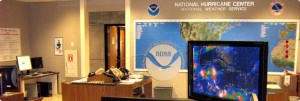 Meteorological research in the United States features a variety of groups and centers tasked with predicting weather and engaging in research about the topic such as the National Hurricane Center (NHC). The NHC is part of the National Centers for Environmental Prediction (NCEP), which is located in Miami, Florida, and it’s also part of the country’s National Weather Service.
Meteorological research in the United States features a variety of groups and centers tasked with predicting weather and engaging in research about the topic such as the National Hurricane Center (NHC). The NHC is part of the National Centers for Environmental Prediction (NCEP), which is located in Miami, Florida, and it’s also part of the country’s National Weather Service.
History of the National Hurricane Center
The ability to predict hurricanes and warn residents of pending danger is something that has become incredibly valuable in today’s world. However, the concept of predicting hurricanes goes back more than a century and predates the arrival of things like computers for prediction models and satellites for tracking.
The frequency of hurricanes in the Caribbean led a man named Father Benito Viñes to create the first hurricane warning center in Cuba in the 19th century. After his passing, the responsibility was picked up by the United States Signal Corp. Eventually, official tracking would move stateside when the federal government would form the Hydrometeorological Prediction Center.
Over the years, the group would undergo a few name changes as the art of predicting hurricanes became more scientific and based upon modern technology. An official tracking center would move to Miami in the 1940s and grow over time to eventually become the National Hurricane Research Project in the 1950s.
By the time the mid-1960s arrived, the National Hurricane Center was up and running in Miami, and it would expand and grow over the next half century to become the group responsible for tropical cyclone advisories, as well as outlooks for tropical weather. Today, the agency issues a report on each tropical cyclone in the Atlantic, as well as in the Eastern Pacific Ocean.
Goals of the NHC
The NHC is located on the campus of Florida International University, and it has a variety of official responsibilities related to its tracking and research of hurricanes. The NHC’s mission is to create effective hurricane watches, warnings, and forecasts, and to successful analyze potentially harmful hurricane-related weather.
Through these efforts, the NHC hopes to accomplish goals that include reducing property loss related to hurricane damage, save lives, and improve economic conditions surrounding the effects of hurricanes. With success in its stated goals, the NHC can become the accurate and trusted source for America’s hurricane information.
Divisions Within the NHC
The NHC has several divisions, which are each dedicated to a specific facet of hurricane study. These divisions help provide forecasts and analyses related to incoming hurricanes. Branches within the NHC include:
- Tropical Analysis and Forecast Branch (TAFB)
- Technology & Science Branch (TSB)
- Storm Surge Unit
- Chief, Aerial Reconnaissance Coordination, All Hurricanes Unit (CARCAH)
- Hurricane Liaison Team (HLT)
Today, each of these units is housed within a weather-resistant building that’s capable of withstanding a category 3 hurricane, which has maximum winds of 129 mph. A Category 3 hurricane is considered one that results in devastating damage to even well-built homes.
Related Resource: Become a Meteorologist
Part of a Larger Umbrella
The primary focus of the NHC is the prediction and research of hurricanes in the tropics, but it’s just one of nine different centers that compose the National Centers for Environmental Prediction. Other centers include the Climate Prediction Center in Maryland and the Storm Prediction Center in Oklahoma. The research at the NHC is always in development. By the year 2020, the National Hurricane Center hopes to see a 50 percent improvement in the group’s ability to forecast hurricanes.